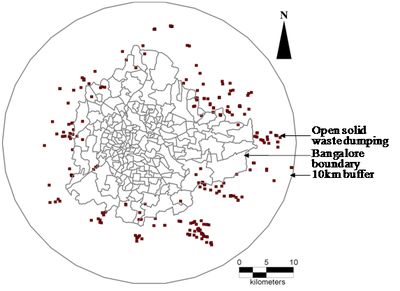Municipal solid waste management is initiated by urban local bodies to protect the environment and the society from adverse impacts of increasing waste quantity. However mismanagement of municipal solid waste wither due to lack of adequate workforce or disregarding a vital functional element in SWM creats serious health and environmental implications. Mismanagement in handling solid wastes are i) mixing of organic and inorganic wastes, ii) open solid waste dumping, iii) unscientific / indiscriminate waste disposal practices and iv) burning of solid waste.
1. Mixing of organic and inorganic waste
Segregation of organic and inorganic waste at source level is most critical stage regarding waste management and recycling processes. If the waste is not separated properly, it reduces the recyclability of waste and increase the volume of waste for transport and at treatment and disposal locations. Biodegradation of waste under anaerobic conditions releases methane while under aerobic conditions releases CO2 to the environment. Apart from these, leachate from waste dumps contaminates the soil and groundwater resources.
2. Open solid waste dumping
Bangalore generates around 3000-4000 tonnes of solid waste daily and a major constituent is organic (72%). The quantum of wastes generated is far greater than the capacity of the three permitted waste treatment and disposal sites at Mavallipura, Mandur and Singehalli. As these locations are quite far-off, many of the trucks dump at unauthorized locations such as roadsides, lake bed, vacant plots, etc. to reduce their transportation costs. The disposal of waste at private or public places in and around cities – i.e. on locations other than the designated urban solid wastes (USW) processing sites is termed as unauthorized dumping.
The waste collected by outsourced agencies dispose waste in vacant places within the city as well as at outskirts/ peri-urban areas. Most dumps inside city are small and waste is dumped at the respective locations for one to two days. However, dumps at outskirts are large (>25 hectares) and waste is being dumped since longer time and organic fractions are degraded with leachates getting into soil. Figure 2 provides the spatial locations of open dumps.
Wastes are dumped in the public and private open lands, agricultural land, road side and at hilly area with no provision for controlling gaseous emission or leachate. Most of the organic wastes are reduced by animals, and a fraction undergoes microbial degradation. Both aerobic and anaerobic degradation takes place in open disposal sites. Methane recovery attempts are reported from two open landfills in Nagpur, India (Bhide et al., 1990).

Fig 2: Open dumpsites located around in and around Bangalore
3. Unscientific waste disposal practice in landfill
Sanitary landfills with options for collecting leachate and gases emission are essential for safe waste disposal. Waste is compacted and daily covered with soil layer. During the final closing of landfill site are effectively capped with thick soil layer. All these factors lead to anaerobic conditions inside the landfill site and hence continuously produce methane gas. Waste composition and age of landfill site are two main factors to influence the extent of methane production. However, sites earmarked for disposal of solid waste in most Indian cities do not adhere to the environment norms. Landfills with unscientific waste disposal practices, is evident from the direct dumping of mixed wastes. These sites are not properly covered with soil and no appropriate collection system for leachate and gaseous emission. Also, these sites receive more quantity of waste than the capacity disturbing the whole system at disposal site.
4. Burning of solid waste
The burning of municipal solid waste at waste disposal sites or at open dump sites is common to reduce the volume of waste or to segregate the metal items from mixed accumulated waste. Usually, this type of incomplete combustion can reduces 40-60% of waste volume. Incomplete combustion of waste during open burning contributes to GHG emissions and other air pollutants. The carbon in MSW has two distinct origins. One is harvested biomass sources like yard trimming, vegetable fruit residues and second is non biomass sources like plastic and synthetic rubber derivative (EPA, 2006). MSW burning results in emission of CO2 and N2O and the carbon stored in harvested biomass sources also looses in the atmosphere which can be recycled back to system.
So, as waste management practices of concern for methane emissions are open dumping, which is generally practiced in developing regions, and sanitary landfilling, generally practiced in developed countries and urban areas of developing countries (IPCC, 1996). Aerobic waste treatment or composting of organic waste emit almost negligible quantity of methane, as waste gets converted and increase the soil organic matter. Whereas, anaerobic waste treatment or biomethanation of waste generate significant quantity of methane, but this methane is collected and used as a source of energy.


